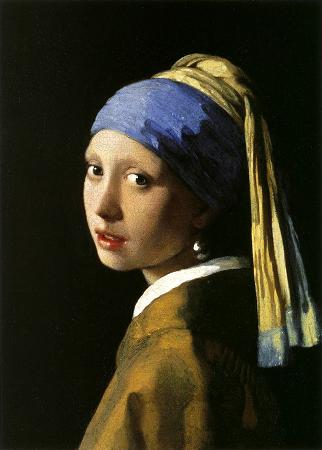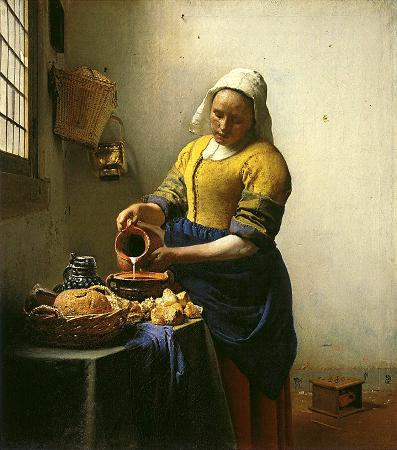Girl with Pearl Earring (c1666). Oil on canvas. 45 x 39. Girl with a Pearl Earring is an oil painting by Dutch Golden Age painter Johannes Vermeer, dated c. 1665. Going by various names over the centuries, it became known by its present title towards the end of the 20th century after the large pearl earring worn by the girl portrayed there. The work has been in the collection of the Mauritshuis in The Hague since 1902 and has been the subject of various literary treatments. In 2006, the Dutch public selected it as the most beautiful painting in the Netherlands. The painting is a tronie, the Dutch 17th-century description of a 'head' that was not meant to be a portrait. It depicts a European girl wearing an exotic dress, an oriental turban, and an improbably large pearl earring. In 2014, Dutch astrophysicist Vincent Icke raised doubts about the material of the earring and argued that it looks more like polished tin than pearl on the grounds of the specular reflection, the pear shape and the large size of the earring. The work is oil on canvas and is 44.5 cm high and 39 cm wide. It is signed IVMeer but not dated. It is estimated to have been painted around 1665. After the most recent restoration of the painting in 1994, the subtle colour scheme and the intimacy of the girl's gaze toward the viewer have been greatly enhanced. During the restoration, it was discovered that the dark background, today somewhat mottled, was initially intended by the painter to be a deep enamel-like green. This effect was produced by applying a thin transparent layer of paint, called a glaze, over the present-day black background. However, the two organic pigments of the green glaze, indigo and weld, have faded. On the advice of Victor de Stuers, who for years tried to prevent Vermeer's rare works from being sold to parties abroad, Arnoldus Andries des Tombe purchased the work at an auction in The Hague in 1881, for only two guilders with a thirty cents buyer's premium. At the time, it was in poor condition. Des Tombe had no heirs and donated this and other paintings to the Mauritshuis in 1902. The painting was exhibited as part of a Vermeer show at the National Gallery of Art in Washington, D.C., in 1965 and 1966. In 2012, as part of a traveling exhibition while the Mauritshuis was being renovated and expanded, the painting was exhibited in Japan at the National Museum of Western Art, Tokyo, and in 2013-2014 the United States, where it was shown at the High Museum in Atlanta, the de Young Museum in San Francisco and in New York City at the Frick Collection. Later in 2014 it was exhibited in Bologna, Italy. In June 2014, it returned to the Mauritshuis museum which stated that the painting would not leave the museum in the future. The painting was investigated by the scientists of the Netherlands Institute for Cultural Heritage and FOM Institute for Atomic and Molecular Physics Amsterdam. The ground is dense and yellowish in color and is composed of chalk, lead white, ochre and very little black. The dark background of the painting contains bone black, weld, chalk, small amounts of red ochre, and indigo. The face and draperies were painted mainly using ochres, natural ultramarine, bone black, charcoal black and lead white. In February-March 2018 an international team of art experts spent two weeks studying the painting in a specially constructed glass workshop in the museum, open to observation by the public. The non-invasive research project included removing the work from its frame for study with microscopes, X-ray equipment and a special scanner to learn more about the methods and materials used by Vermeer. The painting has gone under a number of titles in various countries over the centuries. Originally it may have been one of the two tronies painted in the Turkish fashion recorded in the inventory at the time of Vermeer's death. It may later have been the work appearing in the catalogue to a 1696 sale of painting in Amsterdam, where it is described as a Portrait in Antique Costume, uncommonly artistic. After the bequest to the Mauritshuis, the painting became known as Girl with a Turban and it was noted of its original description in the 1675 inventory that the turban had become a fashion accessory of some fascination during the period of European wars against the Turks. By 1995, the title Girl with a Pearl was considered more appropriate. Pearls, in fact, figure in 21 of Vermeer's pictures, including very prominently in Woman with a Pearl Necklace. Earrings alone are also featured in A Lady Writing a Letter, Study of a Young Woman, Girl with a Red Hat and Girl with a Flute.
more...




